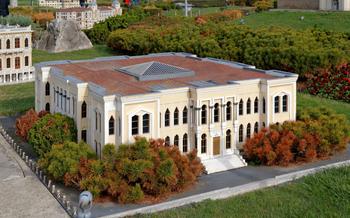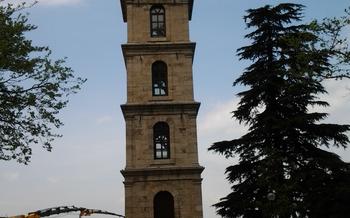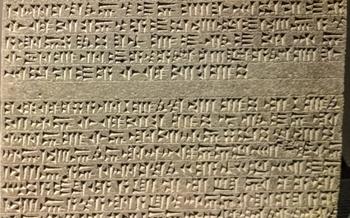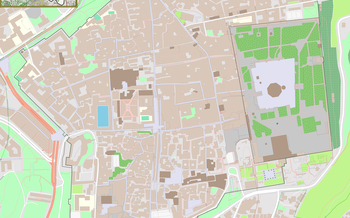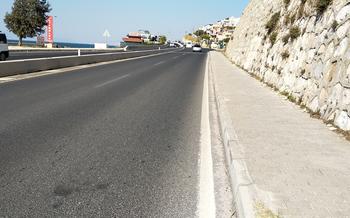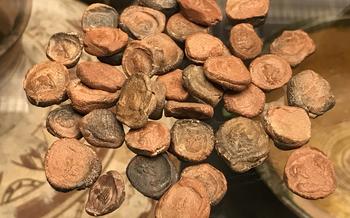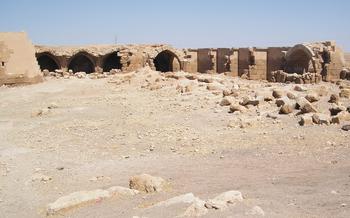
Gadara Bridge
- Van's Historical Significance
- Reaching the Gadara Bridge
- Exploring the Gadara Bridge
- Uncovering the History of the Gadara Bridge
- The Bridge in Ancient Literature
- The Bridge as a Symbol of Resilience
- The Bridge's Contribution to Trade
- The Bridge as a Cultural Landmark
- The Bridge in Modern Times
- Visiting the Bridge: Practical Information
- Guided Tours of the Bridge
- Photography Opportunities at the Gadara Bridge
- Souvenirs and Local Crafts
- Insider Tip: Hidden Gem Near the Bridge
Van's Historical Significance
Van, a city in eastern Turkey, has a rich and storied history. Situated on the shores of Lake Van, the largest lake in Turkey, Van has long been a crossroads of trade and culture, connecting the East and the West. The city's strategic location made it a prized possession for many empires, including the Urartians, Medes, Persians, Greeks, Romans, Byzantines, Seljuks, and Ottomans. Van's historical significance is further enhanced by the presence of the Gadara Bridge, an ancient stone bridge that has witnessed the rise and fall of civilizations. Built in the 2nd century AD, the bridge served as a vital link between the Roman and Persian empires, facilitating trade and cultural exchange. Over the centuries, the bridge has been damaged by earthquakes and floods, but it has always been repaired and restored, a testament to its enduring importance.
Reaching the Gadara Bridge
Van is well-connected to major cities in Turkey and beyond, making it easy to reach by air or land. Several airlines offer direct flights to Van Ferit Melen Airport (VAN) from Istanbul, Ankara, and other major cities. Once in Van, you can take a taxi or rent a car to get to the Gadara Bridge. The journey from the city center to the bridge takes approximately 30 minutes.
If you prefer public transportation, you can take a bus from the Van Bus Terminal to the town of Gevas, which is located near the bridge. From Gevas, you can take a taxi or dolmuş (shared minibus) to the Gadara Bridge. Taxis are readily available at the bus terminal and can be negotiated for a reasonable fare. Dolmuşes are a more affordable option, but they operate on a specific schedule and may require some waiting time.
To navigate the local transportation system effectively, it's advisable to have a basic understanding of Turkish or to travel with a local guide. Alternatively, you can use translation apps or online maps to help you communicate and find your way around.
Exploring the Gadara Bridge
The Gadara Bridge is a remarkable engineering feat that showcases the architectural prowess of the ancient Romans. Constructed using large blocks of basalt, the bridge features a series of arches that gracefully span the river below. The largest arch, located at the center of the bridge, measures an impressive 17 meters in height. It is supported by massive piers that have withstood the test of time.
The bridge's construction is not only a testament to the Romans' engineering skills but also reflects their understanding of the natural environment. The bridge was built on a solid rock foundation, ensuring its stability amidst the shifting currents of the river. The use of basalt, a volcanic rock known for its durability, further contributed to the bridge's longevity.
The Gadara Bridge is not just a historical marvel; it is also a testament to the beauty of the surrounding landscape. Situated amidst rolling hills and lush greenery, the bridge offers breathtaking views of the natural surroundings. Visitors can stroll along the bridge and admire the serene beauty of the river, the verdant valleys, and the distant mountains.
Uncovering the History of the Gadara Bridge
The Gadara Bridge has a rich and storied history. It was built sometime in the 2nd century AD, during the Roman Empire. The exact date of its construction is unknown, but it is believed to have been built during the reign of Emperor Trajan. The bridge was primarily built to facilitate trade and communication between the Roman Empire and the Parthian Empire, which was located to the east. The bridge also served as a strategic military crossing point, as it allowed Roman troops to quickly cross the river and attack Parthian forces.
Over the centuries, the bridge has witnessed numerous historical events. It was damaged during the Byzantine-Sasanian wars of the 6th and 7th centuries AD, and was rebuilt by the Byzantines in the 8th century. The bridge was also damaged during the Mongol invasion of the 13th century, and was again rebuilt by the Ilkhanate dynasty. In the 16th century, the bridge was conquered by the Ottoman Empire, who ruled the region for over 400 years. During the Ottoman period, the bridge was used as a trade route between the Ottoman Empire and the Safavid Empire, which was located to the east.
Despite its age and the many wars and natural disasters it has endured, the Gadara Bridge has survived and remains in use today. It is a testament to the engineering skill of the Romans and the importance of the bridge as a strategic and economic asset.
The Bridge in Ancient Literature
References to the Gadara Bridge can be found in various Roman and Byzantine texts, providing valuable insights into its historical significance. One notable mention is by the Roman geographer Strabo, who described the bridge as a remarkable feat of engineering, highlighting its role in connecting different regions and facilitating trade. Another reference appears in the writings of the Byzantine historian Procopius, who recounted the bridge's strategic importance during the Byzantine-Sassanid wars, emphasizing its role as a key defensive structure. These references underscore the bridge's prominence in ancient literature, further attesting to its enduring legacy.
The Bridge as a Symbol of Resilience
The Gadara Bridge has stood resiliently through the ages, bearing witness to the tumultuous history of the region. Despite the ravages of time, natural disasters, and conflicts, the bridge has endured, a testament to the indomitable spirit of the people of Van.
The bridge's ability to withstand the test of time is a source of pride for the local community. It serves as a reminder of their resilience and their determination to overcome adversity. The bridge has become a symbol of hope and renewal, representing the ability to rise from the ashes of destruction and rebuild a better future.
The bridge's resilience is particularly poignant in light of the many challenges that Van has faced throughout its history. The city has been repeatedly destroyed by earthquakes, most recently in 20However, each time, the people of Van have rebuilt their city and their lives, demonstrating their unwavering resilience.
The Gadara Bridge is a powerful symbol of this resilience. It stands as a reminder that even in the face of adversity, hope and renewal are always possible.
The Bridge's Contribution to Trade
The Gadara Bridge has played a crucial role in facilitating trade between different regions since its construction. Its strategic location across the Van River made it a vital link for merchants and traders traveling between the Middle East and Europe. The bridge enabled the exchange of goods, ideas, and cultures, contributing significantly to the development of the region.
The bridge's impact on the local economy was substantial. It facilitated the transportation of agricultural products, livestock, and other goods from rural areas to urban centers. This boosted trade activities and led to the growth of local markets and businesses. The bridge also played a role in the spread of cultural influences, as travelers and merchants brought new ideas and customs to the region.
The bridge's contribution to trade continues to this day. It remains an important crossing point for both local and international trade, and its economic significance is still felt in the region. The bridge is a testament to the enduring importance of trade and connectivity in promoting economic growth and development.
The Bridge as a Cultural Landmark
The Gadara Bridge's historical and architectural significance has earned it recognition as a UNESCO World Heritage Site. This prestigious designation acknowledges the bridge's outstanding universal value and its contribution to the world's cultural heritage. As a result, the bridge attracts numerous visitors, including history enthusiasts, architecture buffs, and tourists seeking unique cultural experiences.
The bridge's status as a UNESCO World Heritage Site has several implications. Firstly, it ensures that the bridge is protected and preserved for future generations. The designation requires that the bridge be managed and maintained according to international standards, ensuring its long-term integrity. Secondly, the recognition increases the bridge's visibility and appeal to international tourists, contributing to the local economy and promoting cultural exchange.
The Gadara Bridge stands as a testament to the ingenuity and resilience of the people of Van. Its rich history, unique architectural features, and stunning natural surroundings make it a must-visit destination for anyone interested in exploring the cultural heritage of this fascinating region.
The Bridge in Modern Times
The Gadara Bridge continues to serve as a vital transportation link in the region, carrying both local and international traffic. In addition to its practical importance, the bridge has also become a popular tourist attraction, drawing visitors from around the world who come to marvel at its architectural beauty and historical significance.
However, the bridge has also faced a number of challenges in recent years, including increased traffic congestion, pollution, and the effects of climate change. To address these challenges, local authorities have implemented a number of measures, such as traffic calming measures, the construction of new roads and bridges, and the restoration of the bridge's original stonework.
Despite these challenges, the Gadara Bridge remains a symbol of resilience and hope for the people of Van. Its enduring strength and beauty serve as a reminder of the city's rich history and its ability to overcome adversity.
Visiting the Bridge: Practical Information
Visiting hours and admission: The Gadara Bridge is open to the public daily from 9 am to 5 pm. The entrance fee is a nominal amount, which helps to maintain and preserve the bridge.
Facilities and amenities: The bridge is easily accessible by foot or by car, and there is ample parking available. Visitors can enjoy a leisurely stroll across the bridge, admiring the stunning views of the surrounding natural beauty. There are also several picnic spots and barbecue areas located near the bridge, making it an ideal place for a relaxing day out.
Tips for making the most of your visit: To fully appreciate the historical significance of the Gadara Bridge, it is recommended to visit during the spring or summer months when the weather is pleasant, and the views are at their best. Visitors should also bring comfortable shoes, as there may be some walking involved. Additionally, bringing a camera is a must, as there are countless photo opportunities at the bridge.
Guided Tours of the Bridge
Guided tours of the Gadara Bridge offer a wealth of insights into its history, architecture, and significance. Led by knowledgeable local experts, these tours provide visitors with a deeper understanding of the bridge's role in the development of Van and the surrounding region.
One of the main benefits of taking a guided tour is the opportunity to learn about the bridge's construction, its role in ancient trade routes, and the various civilizations that have crossed it throughout history. Guides often share fascinating stories and anecdotes about the bridge's past, bringing its rich history to life.
Another advantage of guided tours is the ability to access exclusive areas of the bridge that may not be open to the general public. For example, some tours may include a visit to the bridge's interior chambers or a walk along its ancient fortifications.
Guided tours are typically offered in multiple languages and can be tailored to suit different interests and preferences. Whether you are a history buff, an architecture enthusiast, or simply someone who wants to learn more about Van's cultural heritage, a guided tour of the Gadara Bridge is a worthwhile experience.
To book a guided tour, you can contact local tour operators or inquire at your hotel or hostel. It is advisable to book in advance, especially during the peak tourist season, to secure your spot.
Photography Opportunities at the Gadara Bridge
The Gadara Bridge is a photographer's paradise. The best time to capture the bridge's beauty is during the golden hours of sunrise and sunset, when the warm light casts a magical glow on the ancient stones. To capture the bridge's grandeur, use a wide-angle lens to take in the entire structure, along with the surrounding natural beauty. For more intimate shots, zoom in on the bridge's intricate carvings and weathered surfaces. Don't forget to experiment with different angles and perspectives to create unique and captivating images. Share your photos on social media using relevant hashtags to inspire others to visit this hidden gem.
Souvenirs and Local Crafts
As you explore the Gadara Bridge, you'll have the opportunity to immerse yourself in the local culture and take home a piece of your experience. The region surrounding the bridge is renowned for its rich craft traditions, and you'll find a variety of souvenirs and local crafts that celebrate the history and beauty of the bridge.
From intricate hand-woven textiles to exquisitely crafted pottery, the local artisans showcase their skills and creativity in every piece. You can find unique souvenirs that capture the essence of the bridge, such as miniature replicas, hand-painted tiles depicting scenes from the bridge's history, or jewelry inspired by its architectural features.
By purchasing these souvenirs, you not only take home a cherished memento of your trip but also support the local economy and contribute to the preservation of traditional crafts. The artisans' dedication to their craft ensures that each piece is one-of-a-kind, carrying the spirit of the Gadara Bridge and the region's rich cultural heritage.
Insider Tip: Hidden Gem Near the Bridge
Just a short walk from the Gadara Bridge lies a hidden gem that often goes unnoticed by tourists. This hidden gem is the Church of the Holy Cross, a beautiful and ancient Armenian church that dates back to the 4th century AD. The church is a testament to the rich history and cultural heritage of Van, and its well-preserved frescoes and intricate carvings are a sight to behold.
Why is the Church of the Holy Cross worth exploring? For one, it is a rare and unique example of early Armenian architecture. The church's interior is adorned with stunning frescoes depicting biblical scenes and historical figures, many of which have been remarkably well-preserved over the centuries. Additionally, the church offers breathtaking views of the surrounding countryside, making it the perfect spot to relax and soak in the beauty of Van.
To get to the Church of the Holy Cross, simply follow the road that leads from the Gadara Bridge towards the village of Akdamar. The church is located on a small hill overlooking the village, and it is easily accessible on foot or by car.
Visiting the Church of the Holy Cross is a great way to delve deeper into the history and culture of Van. Whether you are a history buff, an architecture enthusiast, or simply someone who appreciates beautiful things, this hidden gem is sure to leave you in awe.


